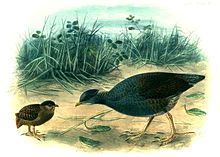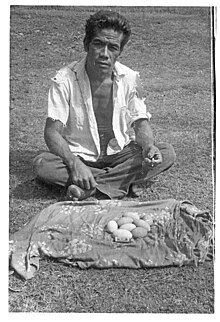Tongan megapode
| Tongan megapode | |
|---|---|

| |
| Scientific classification | |
| Domain: | Eukaryota |
| Kingdom: | Animalia |
| Phylum: | Chordata |
| Class: | Aves |
| Order: | Galliformes |
| Family: | Megapodiidae |
| Genus: | Megapodius |
| Species: | M. pritchardii
|
| Binomial name | |
| Megapodius pritchardii Gray, GR, 1864
| |
| Synonyms | |
| |
The Tongan megapode (Megapodius pritchardii) is a species of
Distribution and habitat
The Tongan megapode is the only remaining species of megapode in Tonga out of the four or five species that were present on the islands in prehuman times (as shown through the fossil record), and indeed the only species of megapode that survives in Polynesia.[2] Similar extinctions occurred in Fiji and New Caledonia, which apparently had three species in prehistory. The species itself once had a more widespread distribution, occurring across most of Tonga, Samoa and Niue.[3] The cause of all these extinctions and declines was the arrival of humans on the islands, and the associated predation on adults and particularly eggs, as well as predation by introduced species.
On Niuafo'ou the small human population and remoteness of its habitat probably saved the species. The only megapode to survive human arrival in Western Polynesia, "the megapode nesting grounds were carefully controlled by the ruling chief, thus assuring the continued survival of this population."[4]
Its natural
Status and conservation

The Tongan megapode is principally threatened by the same factors that caused its decline in the rest of Polynesia. Its eggs are still harvested by local people in spite of theoretical government protection, and some hunting still occurs. The species is apparently afforded some protection by the difficulty in reaching its habitat.
References
- . Retrieved 11 November 2021.
- ^ ISBN 978-0-226-77142-7pp. 291–292
- S2CID 86588636.
- ISBN 0-521-78879-X.
- ^ JSTOR 4160299.
- ^ Birdlife International (2004) "Megapode survey too late" Downloaded 29 July 2008

